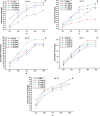Utilizing hydrothermal time models to assess the effects of temperature and osmotic stress on maize (Zea mays L.) germination and physiological responses
- PMID: 37679677
- PMCID: PMC10483708
- DOI: 10.1186/s12870-023-04429-y
Utilizing hydrothermal time models to assess the effects of temperature and osmotic stress on maize (Zea mays L.) germination and physiological responses
Abstract
The application of germination models in economic crop management makes them extremely useful for predicting seed germination. Hence, we examined the effect of varying water potentials (Ψs; 0. - 0.3, - 0.6, - 0.9, - 1.2 MPa) and temperatures (Ts; 20, 25, 30, 35, 40 °C) on maize germination and enzymatic antioxidant mechanism. We observed that varying Ts and Ψs significantly influenced germination percentage (GP) and germination rate (GR), and other germination parameters, including germination rate index (GRI), germination index (GI), mean germination index (MGI), mean germination time (MGT), coefficient of the velocity of germination (CVG), and germination energy (GE) (p ≤ 0.01). Maximum (87.60) and minimum (55.20) hydro-time constant (θH) were reported at 35 °C and 20 °C, respectively. In addition, base water potential at 50 percentiles was highest at 30 °C (15.84 MPa) and lowest at 20 °C (15.46 MPa). Furthermore, the optimal, low, and ceiling T (To, Tb and Tc, respectively) were determined as 30 °C, 20 °C and 40 °C, respectively. The highest θT1 and θT2 were reported at 40 °C (0 MPa) and 20 °C (- 0.9 MPa), respectively. HTT has a higher value (R2 = 0.43 at 40 °C) at sub-optimal than supra-optimal temperatures (R2 = 0.41 at 40 °C). Antioxidant enzymes, including peroxidase (POD), catalase (CAT), superoxide dismutase (SOD), ascorbate peroxidase (APX), and glutathione peroxidase (GPX), increased with decreasing Ψs. In contrast, CAT and POD were higher at 20 °C and 40 °C but declined at 25, 30, and 35 °C. The APX and GPX remained unchanged at 20, 25, 30, and 40 °C but declined at 35 °C. Thus, maintaining enzymatic activity is a protective mechanism against oxidative stress. A decline in germination characteristics may result from energy diverting to anti-stress tools (antioxidant enzymes) necessary for eliminating reactive oxygen species (ROS) to reduce salinity-induced oxidative damage. The parameters examined in this study are easily applicable to simulation models of Z. mays L. germination under extreme environmental conditions characterized by water deficits and temperature fluctuations.
Keywords: Abiotic stress; Antioxidant mechanism; Germination; Hydrothermal time model; Physiological responses.
© 2023. BioMed Central Ltd., part of Springer Nature.
Conflict of interest statement
The authors declare no competing interests.
Figures







Similar articles
-
Using mathematical models to evaluate germination rate and seedlings length of chickpea seed (Cicer arietinum L.) to osmotic stress at cardinal temperatures.PLoS One. 2021 Dec 17;16(12):e0260990. doi: 10.1371/journal.pone.0260990. eCollection 2021. PLoS One. 2021. Retraction in: PLoS One. 2022 Aug 3;17(8):e0272196. doi: 10.1371/journal.pone.0272196. PMID: 34919542 Free PMC article. Retracted.
-
Computing the effects of temperature and osmotic stress on the seed germination of Helianthus annuus L. by using a mathematical model.Sci Rep. 2024 May 1;14(1):9978. doi: 10.1038/s41598-024-60015-8. Sci Rep. 2024. PMID: 38693252 Free PMC article.
-
Quantifying Temperature and Osmotic Stress Impact on Seed Germination Rate and Seedling Growth of Eruca sativa Mill. via Hydrothermal Time Model.Life (Basel). 2022 Mar 9;12(3):400. doi: 10.3390/life12030400. Life (Basel). 2022. PMID: 35330151 Free PMC article.
-
Physiological and Germination Responses of Muskmelon (Cucumis melo L.) Seeds to Varying Osmotic Potentials and Cardinal Temperatures via a Hydrothermal Time Model.ACS Omega. 2023 Sep 7;8(37):33266-33279. doi: 10.1021/acsomega.3c01100. eCollection 2023 Sep 19. ACS Omega. 2023. PMID: 37744846 Free PMC article.
-
Using Halothermal Time Model to Describe Barley (Hordeumvulgare L.) Seed Germination Response to Water Potential and Temperature.Life (Basel). 2022 Jan 29;12(2):209. doi: 10.3390/life12020209. Life (Basel). 2022. PMID: 35207497 Free PMC article.
Cited by
-
The germination response of Zea mays L. to osmotic potentials across optimal temperatures via halo-thermal time model.Sci Rep. 2024 Feb 8;14(1):3225. doi: 10.1038/s41598-024-53129-6. Sci Rep. 2024. PMID: 38332029 Free PMC article.
-
The Impact of Water Potential and Temperature on Native Species' Capability for Seed Germination in the Loess Plateau Region, China.Plants (Basel). 2024 Feb 29;13(5):693. doi: 10.3390/plants13050693. Plants (Basel). 2024. PMID: 38475540 Free PMC article.
References
-
- Nawaz F, Naeem M, Akram A, et al. Seed priming with KNO3 mediates biochemical processes to inhibit lead toxicity in maize (Zea mays L.) J Sci Food Agric. 2017;97:4780–4789. - PubMed
-
- Meeks M, Murray SC, Hague S, Hays D. Measuring maize seedling drought response in search of tolerant germplasm. Agronomy. 2013;3:135–147.
-
- Cakir R. Effect of water stress at different development stages on vegetative and reproductive growth of corn. Field Crop Res. 2004;89:1–16.
-
- Naseer MA, Nengyan Z, Ejaz I, et al. Physiological Mechanisms of Grain Yield Loss Under Combined Drought and Shading Stress at the Post-silking Stage in Maize. J Soil Sci Plant Nutr. 2022;23:1125–37. 10.1007/s42729-022-01108-z.
MeSH terms
Substances
Grants and funding
LinkOut - more resources
Full Text Sources
Medical
Miscellaneous

